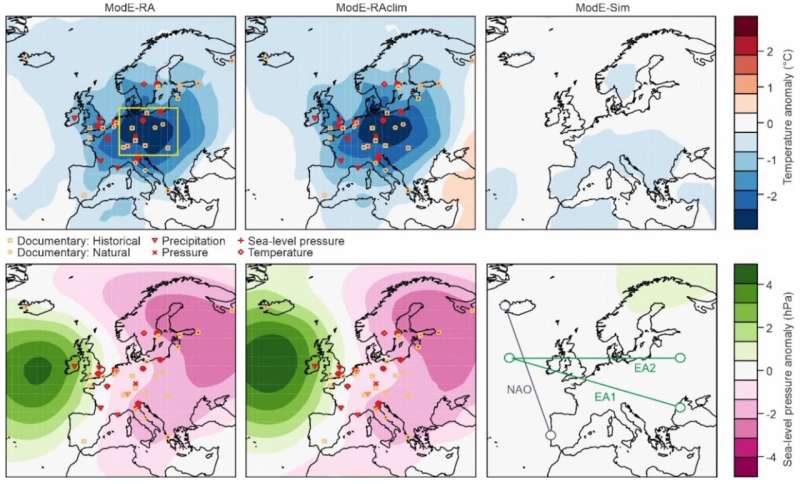June 18, 2024 feature
This article has been reviewed according to Science X's editorial process and policies. Editors have highlighted the following attributes while ensuring the content's credibility:
fact-checked
peer-reviewed publication
trusted source
proofread
The year 1740 was the coldest in Central Europe in 600 years: Study seeks to answer why

Europe experienced its coldest winter in 600 years during 1739–1740, ~4 °C cooler than the present average, also coinciding with negative temperature anomalies across North America and Eurasia. Indeed, for northern midlatitudes (35–70 °N) as a whole, it may have been the coldest season in the last 300 years.
At the time, there was heavy snowfall, severe frost and frozen rivers (ice thickness > 50 cm), which led to extreme flooding upon melting, the destruction of crops (in particular potatoes and cereals) and the death of cattle and fish. The famine that occurred in Ireland between 1740–1741 is believed to be a direct consequence of this disruption to food supplies.
While instrumental records existed, new global climate reconstructions have allowed scientists to investigate this anomalous season in further detail in a new publication in Climate of the Past. Professor Stefan Brönnimann, of the University of Bern, Switzerland, and colleagues reconstructed monthly climate and daily weather patterns in order to determine the mechanisms behind this extreme winter, which began in October 1739 and lasted through to June 1740.
The scientists combined instrumental measurements with weather diary observations from Gdańsk (Poland), Berlin (Germany), Versailles (France) and Saint-Blaise (Switzerland) to plot maps of daily temperature, pressure and weather patterns.
They identified the first half of January 1740 as being "extraordinarily" cold, 6 standard deviations below the mean temperature of Western Europe, which gradually spread southwards over the next few months and was coincident with a strong increase in atmospheric pressure initiated over Scandinavia. This had a blocking effect, causing cold air from the continent to flow westwards.
From February to June, high pressure prevailed over Ireland and drew cold air from the North Atlantic before spreading further over the European continent, causing two further negative temperature anomalies in March and May of that same year. Following this, the summer months of July and August experienced cold and rainy cyclonic weather patterns over Central Europe.

To explain these anomalies, the researchers investigated the role of the North Atlantic Oscillation, which was in a negative phase during 1740; this is when air pressure over the north and central North Atlantic Ocean is weaker, leading the jet stream to bring cooler temperatures and reduced precipitation. They found that this ocean-climate cycle was not experiencing extreme conditions during this particular year, so something else must have been driving the cold weather.
Instead, they turned to the East Atlantic pattern (similar to North Atlantic Oscillation but running east to west across the ocean basin), which experienced an unusual negative phase during spring 1740 (the first of its kind since these specific records began in 1421). This would have led to below-average temperatures across Europe as a whole, as well as below-average precipitation to the north and above-average to the south of the continent.
Professor Brönnimann and the team added the influence of El Niños to the model but did not find a statistically significant correlation with them influencing the North Atlantic Oscillation or the East Atlantic pattern. Additionally, it is noted that reconstructing El Niño patterns from ~300 years ago involves a lot of uncertainty.
The team also tested the role of the eruption of Mount Tarumae, Japan, between 19-31 August 1739, which had a global forcing of -2.4 Wm-2 and reached 5 (out of 8) on the volcanic explosivity index, but they again found only weak positive effects on the North Atlantic Oscillation and the East Atlantic pattern.
This research is interesting, as the anomalous cold snap was followed by two further cold winters in 1741 and 1742, which had been preceded by a mild decade in the 1730s. While the uniqueness of the negative East Atlantic pattern that persisted for almost a year is determined to be a primary driver of the 1739–40 cold winter, the mechanism causing that still remains elusive.
More information: Stefan Brönnimann et al, The weather of 1740, the coldest year in Central Europe in 600 years, Climate of the Past (2024). DOI: 10.5194/cp-2024-40
Journal information: Climate of the Past
© 2024 Science X Network




















